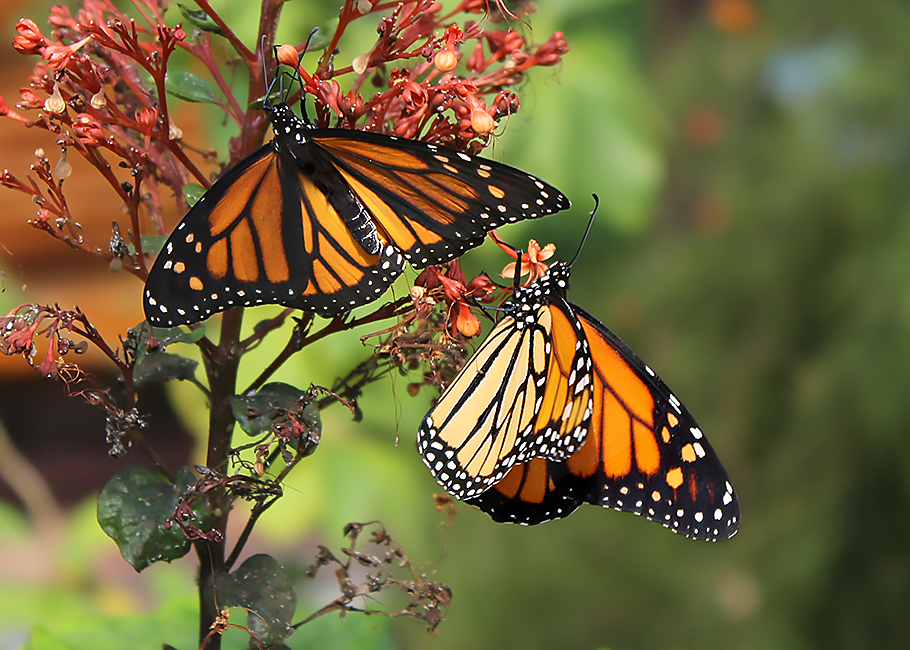
by Mary Salinas | Dec 14, 2017
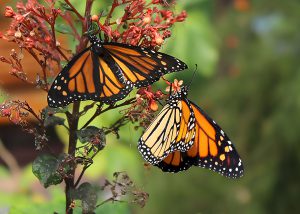
Monarch butterflies. Photo credit: Pia-Riitta Klein.
We have grown to love monarch butterflies, with their striking orange and black markings and their fascinating annual migration from southern Canada 3,000 miles south to Mexico. To help them, we have increasingly planted milkweed, the only plant on which their caterpillars will feed. In northwest Florida, the milkweed species most planted has been tropical milkweed, Asclepias curassavica, as it is lush, showy and easy to grow.
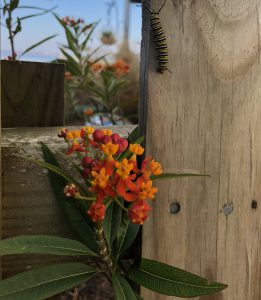
Tropical milkweed, Asclepias curassavica, was visited by this monarch caterpillar who is now off to find a suitable place to make his transformation into a chrysalis. Photo by Mary Salinas, UF/IFAS Extension.
Tropical milkweed, unlike our native milkweeds that die back in late fall, will continue to grow through the winter unless killed by a hard freeze. Even if the cold kills the stems, it may regrow quickly from the roots. This seems like an advantage, but maybe not. The availability of a host plant for the caterpillars may be prompting adult females to stay and lay eggs rather than migrate south and be protected from deadly freezes.
Experts are also exploring links between the longer persistence of the tropical milkweed into winter and a build-up on those plants of a serious parasite Ophryocystis elektroscirrha, commonly referred to as OE.
So, what is the answer?
- Cut back any tropical milkweed to the ground at Thanksgiving. That may encourage female monarchs to migrate and prevent a deadly build-up of OE spores on the plants.
- Consider adding some native milkweed species to your butterfly garden. Here are some recommended species from Dr. Jaret Daniels:
- Aquatic Milkweed (Asclepias perennis)
- Swamp Milkweed (Asclepias incarnata)
- Pinewoods Milkweed (Asclepias humistrata)
- Redring Milkweed (Asclepias variegata)
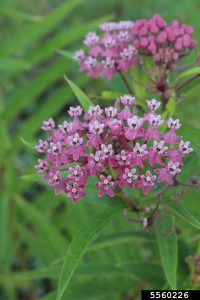
Swamp Milkweed, Asclepias incarnata. Photo credit: Chris Evans, University of Illinois.
For more information:
Are non-native milkweeds killing monarch butterflies?
Monarch Joint Venture: Potential risks of growing exotic (non-native) milkweeds for monarchs
Monarch Butterfly, Danaus plexippus Linnaeus (Lepidoptera: Nymphalidae: Danainae)
MonarchWatch.org
Gardening Solutions: Milkweed
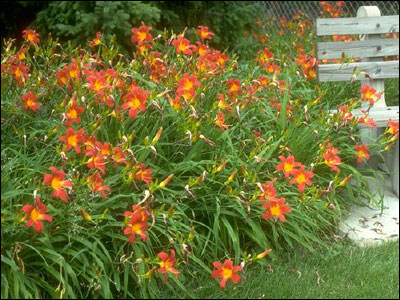
by Les Harrison | Oct 16, 2017
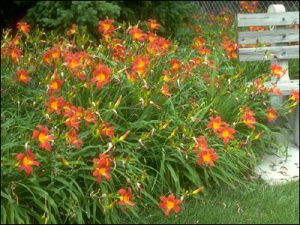
Daylilies in full bloom. Image credit UF / IFAS Solutions Website
“A penny saved is a penny earned” is the famously frugal advice from Poor Richard’s Almanac. The author Benjamin Franklin, elder statesman and founding father of the United States, offered this simple pearl of wisdom to 18th century American colonist to remind them to cautiously manage their assets.
This concept has met the test of time and had been resurrected in a variety of guises. Individuals, families, companies and governments have all applied a variation of this resource management concept, especially when their economic outlooks are challenged.
As basic as the idea is it can be applied to almost any situation, even the home landscape. Daylilies, the commonly encountered flowering ornamental in many 21st century gardens, is an excellent example of getting the most return for the least output.
The daylily is a popular flowering perennial with East Asian origins which has adapted well to Florida landscapes. Plants are available in a wide variety of growth habits, flower shapes and colors, including yellow, orange, red, pink, purple, near-white and shades and combinations of all of these.
Flowering starts in March for early-season bloomers with late-season cultivars starting in mid-May. The typical bloom period is about four to seven weeks, although some varieties bloom even longer.
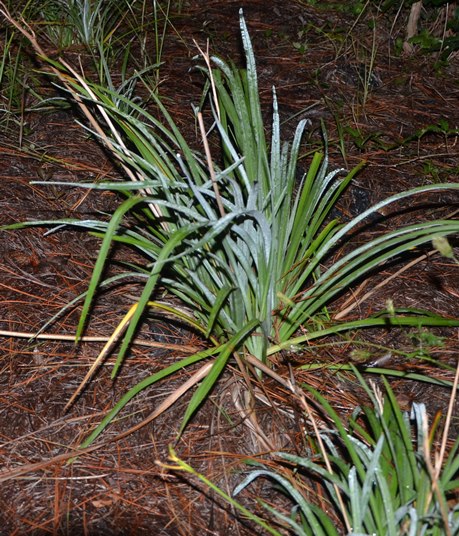
Daylilies are colorful and easy to grow. Propagation is easy this time of year, just dig, separate, and replant.
As their name accurately indicates, daylilies are members of the lily family, in the genus Hemerocallis. “Hemero” is Greek for “day” and “callis” for “beauty,” so the scientific name translates to beauty for a day.
For the adventurous eater, the flower buds and petals of daylilies are edible raw, boiled, stir-fried, steamed, stuffed, or battered and fried. Dried daylily petals, called “golden needles,” are used in numerous Chinese dishes.
Many of the modern varieties of daylilies available today have been developed from native Chinese species. Early settlers from Europe and Asia brought many of the original species with them to America.
Daylilies grow best in full sun or filtered shade. The darker colored red and purple varieties flourish better in partial shade, while light colored yellows, pinks and pastels varieties need full sun to bring out their best colors.
The filtered light level under pine trees is ideal for growing daylilies. Heavy shade should be avoided because it will cause thin, spindly growth and poor flowering.
The soil pH should be between 6.2 and 6.8, with 6.5 being optimal.
The soil of daylily beds should be topped with three to four inches of organic matter, such as peat, compost, or well-rotted manure. The amended soil should be mixed or tilled, leveled and then moistened.
Daylilies survive dry conditions well because of their extensive root systems. However, the number and size of blooms, plant growth, and overall vigor can be adversely affected by prolonged drought.
Daylilies multiply fairly rapidly and plant division is an easy way to propagate them for new locations in the home landscape or to share with friends. Division is best done immediately after the flowering season.
Dig the entire clump and shake or wash off the soil without damaging the roots. It is easy to see where the divisions can be made with smaller clumps being easily pulled free to establish a new planting.
The home gardener can expand and share the beauty of these perennials and only spend a little time to accomplish this. No doubt Ben Franklin and Poor Richard would approve.
For more information, check out this excellent publication titled “Daylilies for Florida”.

by Sheila Dunning | Oct 2, 2017
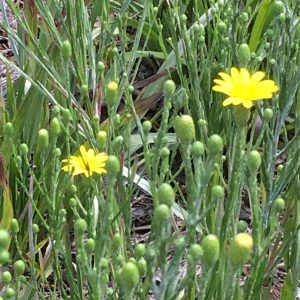
Silkgrass Pityopsis spp. Picture by: Sheila Dunning
Each fall, nature puts on a brilliant show of color throughout the United States. As the temperatures drop, autumn encourages the “leaf peepers” to hit the road in search of the red-, yellow- and orange-colored leaves of the northern deciduous trees.
Here in the Florida Panhandle, fall color means wildflowers. As one drives the roads it’s nearly impossible to not see the bright yellows in the ditches and along the wood’s edge. Golden Asters (Chrysopsis spp.), Tickseeds (Coreopsis spp.), Silkgrasses (Pityopsis spp.), Sunflowers (Helianthus spp.) and Goldenrods (Solidago spp.) are displaying their petals of gold at every turn. These wildflowers are all members of the Aster family, one of the largest plant families in the world. For most, envisioning an Aster means a flower that looks like a daisy. While many are daisy-like in structure, others lack the petals and appear more like cascading sprays.
So if you are one of the many “hitting the road in search of fall color”, head to open areas. For wildflowers, that means rural locations with limited homes and businesses. Forested areas and non-grazed pastures typically have showy displays, especially when a spring burn was performed earlier in the year.
With the drought we experienced, moist, low-lying areas will naturally be the best areas to view the many golden wildflowers. Visit the Florida Wildflower Foundation website, www.flawildflowers.org/bloom.php, to see both what’s in bloom and the locations of the state’s prime viewing areas.
And if you are want to add native wildflowers and other Florida-friendly plants to your landscape join the Master Gardeners for their Fall Plant Sale to be held Saturday, October 14 from 8 am to noon at the Okaloosa County Extension Annex located at 127 SW Hollywood Blvd, Ft. Walton Beach.
by Matthew Orwat | Sep 18, 2017
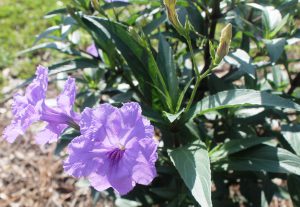
Individual Ruellia ‘Mayan Compact Purple’ flower. Image Credit: Matthew Orwat
Avid horticulturists often get frustrated when attractive, floriferous, versatile, durable, and easy-to-grow plants get sidelined because they have been declared an invasive species. Ruellia simplex (commonly known as Mexican petunia) was declared a category 1 invasive in 2001 by the Florida Exotic Pest Plant Council, described as “a plant that is altering native plant communities by displacing native species, changing community structures or ecological functions, or hybridizing with natives” (Source: UF/IFAS Center for Aquatic and Invasive Plants).
It produces copious amounts of seed year-long, which do not require exposure to cold weather (stratification) or mechanical damage (scarification) to germinate. Its excellent garden characteristics such as prolific flower production, and adaptability to varying light, temperature and moisture levels also increase its invasive potential.
Fortunately, recent developments in the field of plant breeding have developed several sterile Ruellia cultivars that have demonstrated low invasive potential in field trials. UF / IFAS researchers have developed the MayanTM series, which includes four distinct new cultivars: ‘MayanTM White’, ‘MayanTM Pink’, ‘MayanTM White’ and’ MayanTM Compact Purple’. They are available to the public through various licensed nurseries.
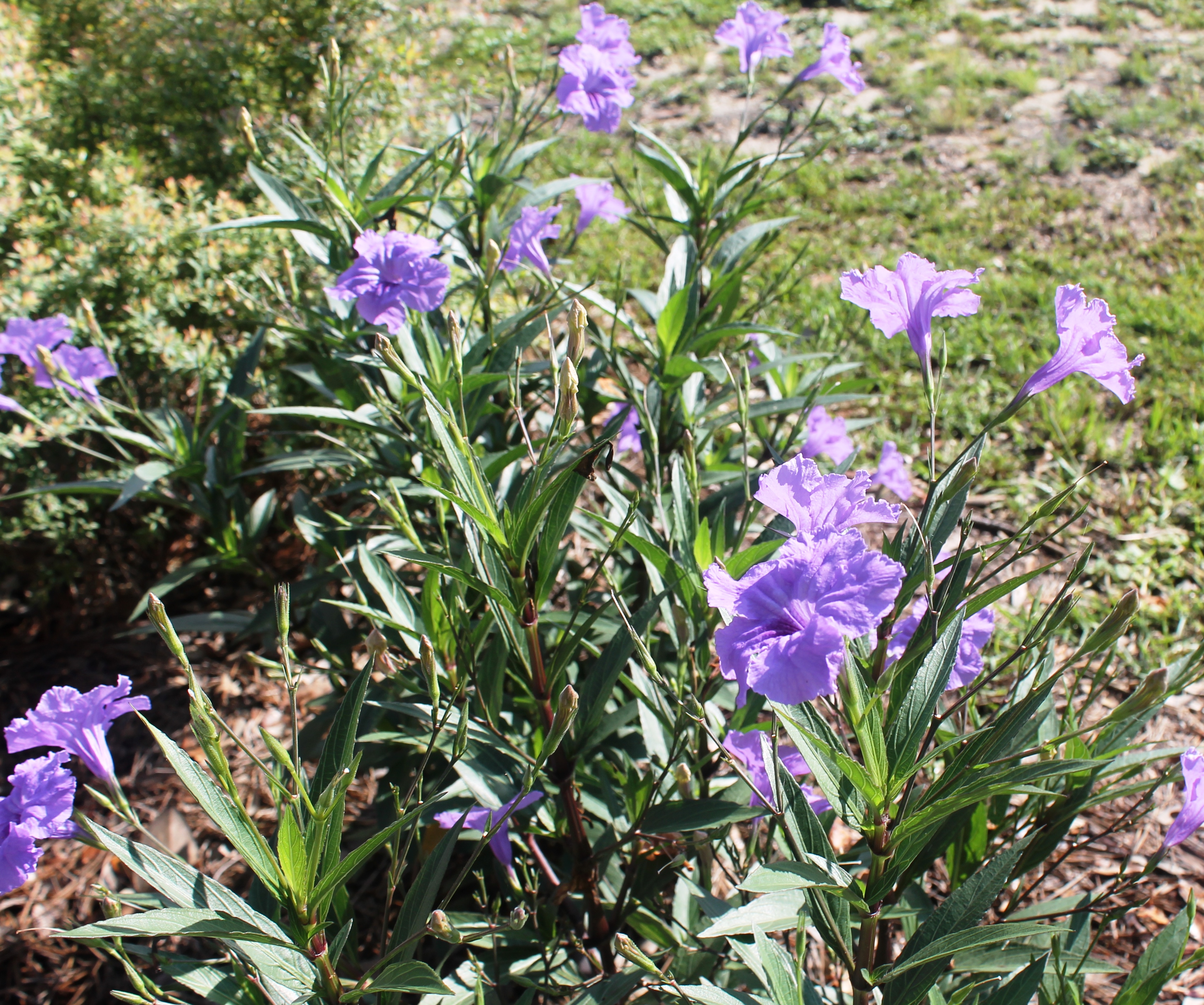
Three month old plant of Ruellia ‘Mayan Compact Purple’ in full flower. Image Credit: Matthew Orwat
This spring, UF/IFAS Extension agents were given the opportunity to try MayanTM Series Ruellia at their local offices. I opted to try the ‘MayanTM Compact Purple’ cultivar and so far it has been an excellent landscape plant. It is shorter than other Ruellia cultivars and has adequate branching throughout so as to not look leggy. It blooms regularly and flowers have a nice, purple hue. It does not mind full morning sun but benefits from afternoon shade, particularly during the hot summer months. So far, it seems like an excellent selection for plant borders or areas where a durable source of color is needed. Additionally, it produces no fruit and very little viable pollen, so it does not have potential to hybridize with naturalized Ruellia simplex populations.
Although this is a sterile selection, it can still multiply by rhizomes. While I have not observed any invasive behavior in ‘MayanTM Compact Purple’, I have just tested it in one location.
For more information consult this article from Florida Foundation Seed Producers and one from Hort Science on the ‘MayanTM Compact Purple’ cultivar.
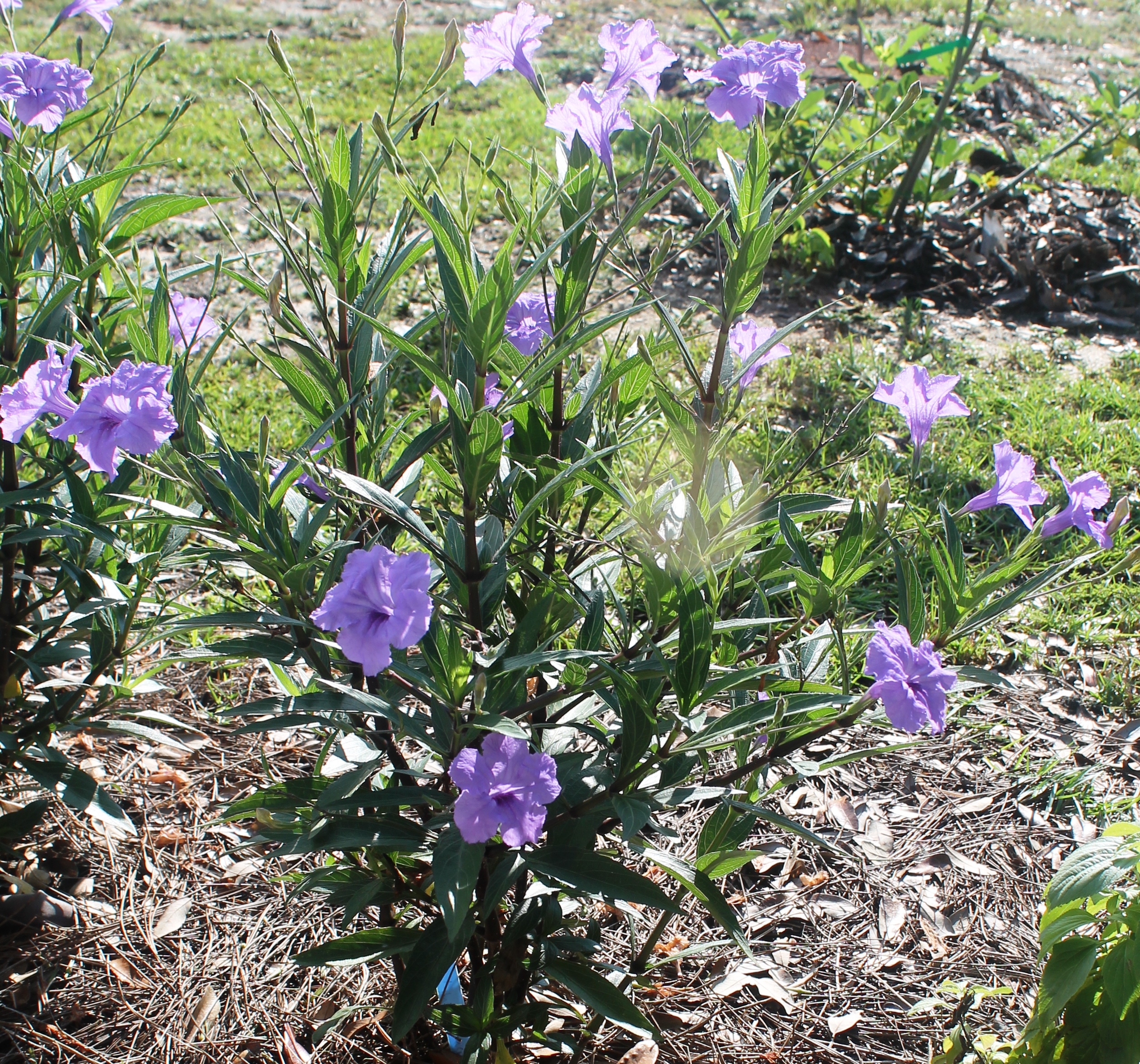
Ruellia ‘Mayan Compact Purple’. Image Credit: Matthew Orwat
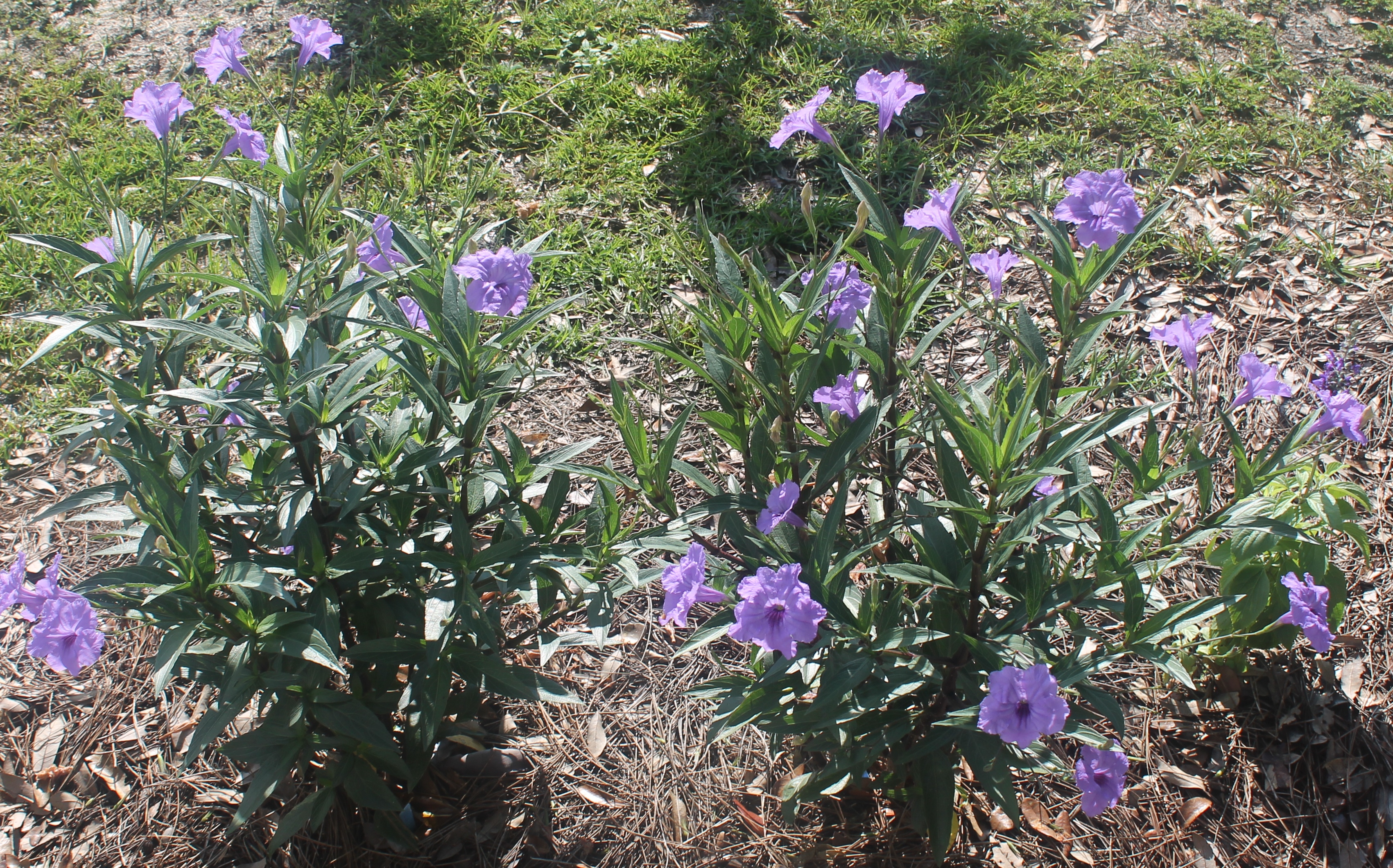
Ruellia ‘Mayan Compact Purple’ Image Credit: Matthew Orwat
by Gary Knox | Aug 17, 2017
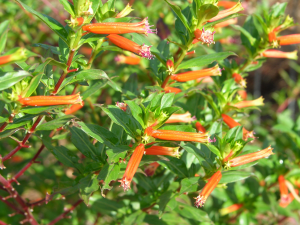
Cuphea ignea
Photo courtesy: Gary Knox
Cupheas are perennials that produce bright orange, red, yellow or purple flowers all summer and fall. Some species are called cigar plants due to their tubular, cigar shaped flowers tipped in red or yellow (like a lit cigar). Others are sometimes called firecracker plants because their cylindrical flowers are bright red or orange (looking like a firecracker). By any name, their nectar-filled, tubular flowers are widely known for attracting large numbers of hummingbirds, butterflies and bees. In addition, young stems of some species are reddish, further adding color and contrast to the usually narrow, lance-shaped green foliage.
As a group, cupheas grow best in full to part sun (the brighter, the better) and well-drained, moderately fertile soil. Cupheas are drought tolerant once established, but grow faster and larger with regular moisture and occasional fertilization. Their origins in warm climates allow them to thrive in heat, but likewise make some species sensitive to cold winters. Those that are frost tender along the Gulf Coast are best placed in a sheltered location in the garden. Cupheas are pest and disease resistant and are not invasive in Florida. They are not truly deer resistant, yet reports suggest cupheas are not favored by deer.
Cupheas are great summer performers in bright, hot and dry locations. Flowering begins in summer and continues through fall until short days and cool weather reduce flowering or frosts cause dieback. Along the Gulf Coast, cool winter weather slows them down, so re-growth doesn’t occur until mid to late spring, and flowering usually doesn’t begin until days and nights are warm. Growth and appearance of many cupheas are improved if plants are pruned or cut to the ground in late winter.
Over 200 species of Cuphea are native to Mexico and the warm-temperate and tropical Americas. Of these and their hybrids, the cupheas listed below are great summer-flowering perennials for the northern Gulf Coast.
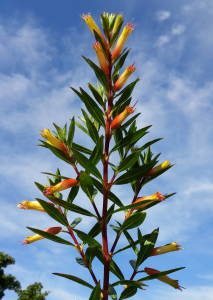
Cuphea micropetala
Photo courtesty: Gary Knox
Cigar Plant (Cuphea ignea)
This fine-textured plant produces red to orange tubular flowers about an inch long. This cigar plant is hardy to about 20°F. It grows about 2 feet tall and 3 feet wide along the Gulf Coast, though it would be a larger, evergreen shrub in warmer climates. This cuphea tends to have lanky growth, so occasional summer pruning will stimulate branching which results in more dense growth.
Cigar Plant or Candy Corn Plant (Cuphea micropetala)
Flowers are 1.5 inches long, emerge pale yellow and gradually turn orange from the base upwards, offering a colorful, two-tone effect. Foliage is hardy to 25-30°F and this cigar plant is root hardy to at least 15°F. Stems should be cut back to ground level in late winter to keep the plant tidy. Clumps spread slowly outward by rhizomes, and the plant will reach 3 feet tall and wide along the Gulf Coast.
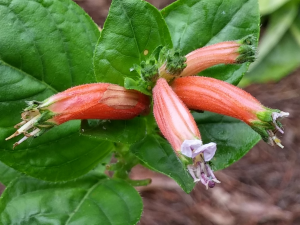
Cuphea schumannii
Photo courtesy: Gary Knox
Orange Cigar Plant or Schumann’s Cuphea (Cuphea schumannii)
This sprawling, floriferous cigar plant prefers moist, well-drained soil to thrive. Barrel-shaped, 1- to 1½-inch blooms are orange and yellow and sometimes have small purple petals at the tips. Flowers cover the branch terminals in the heat of summer and into fall. This plant is hardy in Zones 8 to 9 (at least down to the mid 20s°F). Unlike many other cupheas, leaves of orange cigar plant are oval- to heart-shaped. Stems grow 2 to 3 feet tall and readily flop or fall over. Plan to give orange cigar plant lots of room to sprawl through the garden!
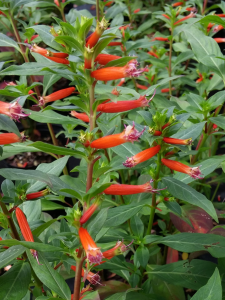
Cuphea ‘David Verity’
Photo courtesy: Gary Knox
‘David Verity’ Large Firecracker Plant (Cuphea ignea × micropetala ‘David Verity’)
This floriferous hybrid produces flowers that are dark orange with a short yellow-orange flared tip and purple filamentts. Well-adapted to the Gulf Coast, this plant is foliage hardy down to 25-30°F and root hardy to at least 15°F. In Zone 9 this plant will grow as an evergreen shrub up to 4 to 5 feet tall and wide, but it will be smaller in areas where frost or freezes occur. This selection is believed to be a hybrid between Cuphea ignea and C. micropetala that was given in the mid 1970s to David Verity, then the manager of the UCLA Mildred Mathias Botanic Garden. It was subsequently named for him when later brought into commercial production.
‘Vermillionaire®’ Large Firecracker Plant (Cuphea ‘Vermillionaire®’)
This new hybrid appears to be a superior cuphea because it grows as a naturally compact plant that produces more flowers than other selections. ‘Vermillionaire®’ grows about 24 inches or more tall and wide with a compact, mounding habit. Orange tubular flowers are produced continuously until late fall. This cuphea is too new to know the full extent of its hardiness, but it is expected to be a perennial in Zones 8 and higher.
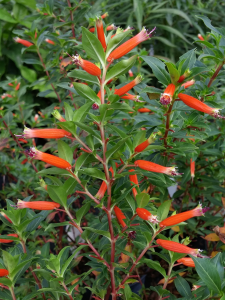
Mexican Heather (Cuphea hyssopifolia)
Unlike the previous cupheas, this plant has small purple flowers, and some selections sport white flowers. Another difference is Mexican heather’s finely textured, bright green leaves. Gulf Coast Zone 8 plants are usually killed to the ground in winter, often recovering by summer but resulting in a compact plant growing less than 24 inches tall and wide. In Zones 9 and higher, Mexican heather is a larger-growing semi-evergreen tropical shrub. Reported pests are leaf-chewing beetles (Altica and Colaspis spp.) and the twig-dwelling lesser snow scale (Pinnaspis strachani). Mexican heather works well for edging beds or sidewalks, helping to define and soften pathways. Cultivars include Allyson, Lavender Lace, Purple Nurple™ and the white-flowered Monga (Itsy Bitsy° White) and ‘White Whispers’.
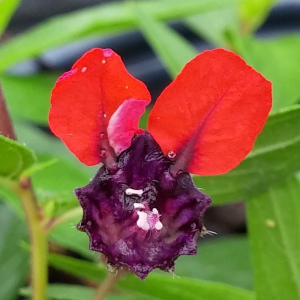
Bat-Faced Cuphea
Photo courtesy: Gary Knox
Bat Face Cuphea (Cuphea llavea)
Each 1-inch flower consists of a purple tube lipped with two red, upright lobes. By viewing the flower with its tip facing you, it takes only a little imagination to see the two red lobes resemble large “ears” above the purple “face” of a bat, hence the name. Along the Gulf Coast, bat face cuphea grows mound-shaped 8 to 24 inches tall and wide, depending upon the selection. It is very heat and drought tolerant but requires better drainage than the other cupheas. Bat face cuphea is evergreen down to the upper 20s°F and root hardy into the lower 20s°F. Improved forms of bat face cuphea include the cultivars, Flamenco Samba, Georgia Scarlet, Mellow Yellow, Miss Priss, Tiny Mice®, Sriracha™ Pink, Sriracha™ Violet, Torpedo, Vienco° Lavender and Vienco° Red.
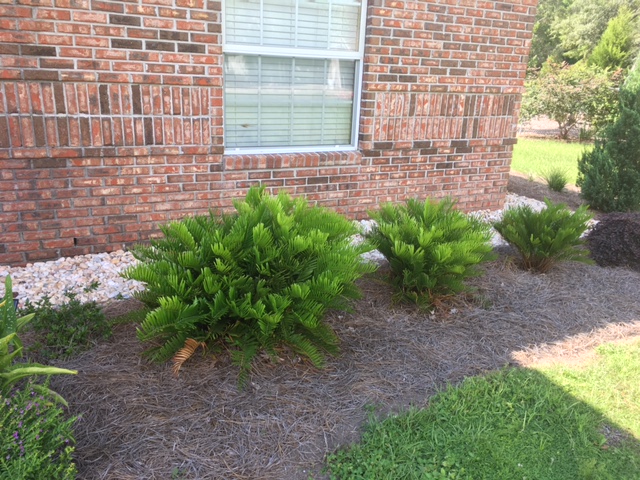
by Julie McConnell | Jul 12, 2017
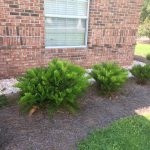
Coontie (Zamia floridana) planted at the same time but growing at different rates. Photo: J_McConnell, UF/IFAS
When designing landscapes, it is popular to create lines and masses of plants for high visual impacts. Plants are carefully selected to be similar in size and shape at the time of installation. They are all grouped together, so they must be getting the same care, but why do they look different years later? There are several factors to consider when we are trying to figure out why a perfectly matched set no longer looks like a uniform planting.
Although plants may be in the same bed, shadows cast at certain times of the day may reduce sunlight to some sections and not others. This can be caused by structures or trees that have grown over time and changed light patterns.
Supplemental irrigation may also be variable even with the best system design. Over time plants grow and may block sprinkler emitters from reaching some sections of landscape beds. Even if the landscape relies on natural rainfall, there can be still be dry/wet spots in the landscape due to drainage off of hard structures, low areas, or wind direction during storms.
It might be possible to adjust some lighting and watering issues, but there is one factor that many gardeners have not considered – genetics. If plants were grown from seed, than variation is not only possible, but likely. This might be displayed as differences in height and width, foliage color, flower color, speed of growth – all may be influenced by parentage despite best efforts to care for each plant similarly.
Many landscape plants are cultivars. This means they are grown from cuttings or divisions which make them identical to the original plant. When a plant is grown from seed, however, there is no guarantee it will have the same specific qualities as the mother plant.
To combat this phenomenon, landscapers should check sunlight and watering for irregular growth patterns and adjust if needed. If a landscape design requires uniform plants, use named cultivars rather than seedling grown plants in lines or masses.





















